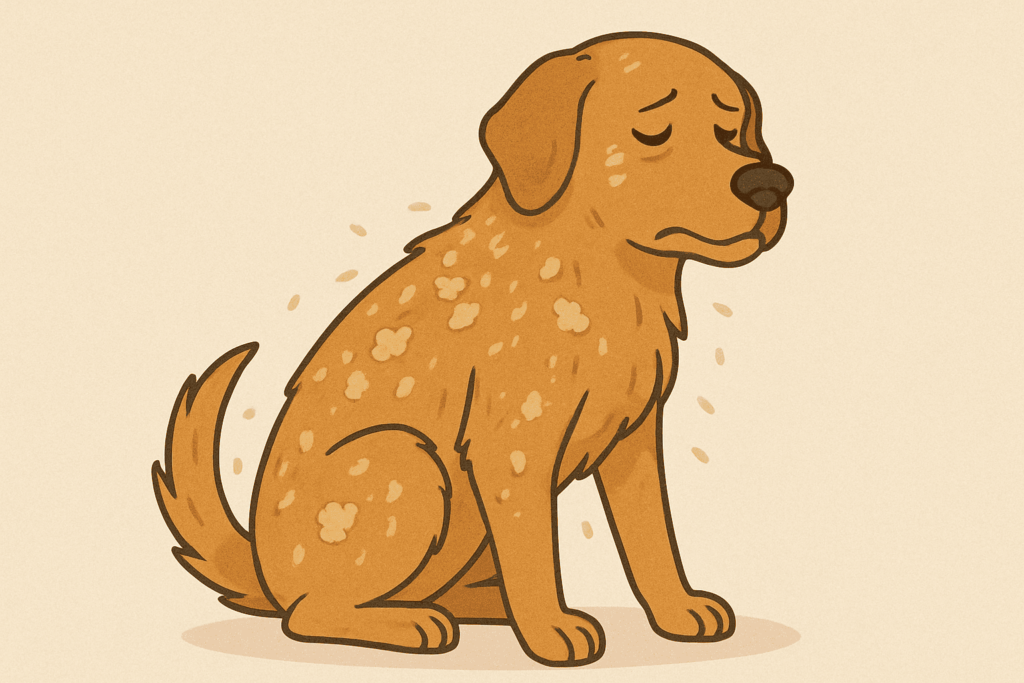Is your dog itching with no fleas in sight? If your pup can’t stop scratching but shows no signs of fleas, it’s a sign something else might be going on. This is a common concern among dog parents — and it’s one you shouldn’t ignore.
In this guide, we’ll explore 10 possible causes of dog itching without fleas, and offer simple, effective ways to help your furry friend feel better fast.
🌿 1. Environmental Allergies
One of the most common causes of dog itching with no fleas is environmental allergies. Dogs can be allergic to things like pollen, grass, mold, and dust mites.
Symptoms:
- Scratching paws, belly, and face
- Red, inflamed skin
- Sneezing or watery eyes
Solutions:
- Wipe your dog’s paws after walks
- Use air purifiers indoors
- Ask your vet about allergy testing
🍗 2. Food Allergies or Sensitivities

If your dog is scratching but has no fleas, their diet might be to blame. Certain ingredients — like chicken, beef, or grains — can trigger allergic reactions in sensitive dogs.
Food allergies can cause itching and skin irritation. Read more about common dog food allergies on PetMD.
What to watch for:
- Itchy ears and paws
- Chronic ear infections
- Upset stomach or diarrhea
How to help:
- Try a limited-ingredient dog food
- Consider a vet-guided elimination diet
💧 3. Dry Skin
Dry skin is another sneaky cause of dog itching with no fleas. It’s especially common during colder months or in dry climates.
Signs:
- Flaky or scaly skin
- Dandruff
- Constant licking or scratching
Relief tips:
- Use a moisturizing dog shampoo with oatmeal or aloe
- Add omega-3 supplements like fish oil
- Avoid frequent baths
🦠 4. Skin Infections
These infections can cause serious itchiness — even if fleas aren’t present. Learn more about how to identify and naturally treat these in our dog skin problems guide.
Symptoms:
- Red or oozing patches
- Hair loss
- Bad odor
Treatment:
- See your vet for a skin check
- Use prescribed antifungal or antibacterial products
🕷 5. Mites or Mange
If your dog is itching with no fleas, mites may be the hidden culprit. Mange — caused by tiny mites — leads to intense itching, especially around the ears, face, and legs.
What to look for:
- Constant scratching
- Scabs or crusty skin
- Patches of missing fur
What to do:
- Have your vet do a skin scrape
- Prescription treatment is typically required
🧼 6. Irritation from Products or Chemicals
Sometimes the issue is something your dog is coming into contact with — like a new shampoo, household cleaner, or lawn treatment.
Common irritants:
- Scented grooming products
- Carpet cleaners
- Laundry detergents
How to fix it:
- Switch to unscented or natural products
- Rinse paws after outdoor play
- Avoid harsh chemicals around your dog
😰 7. Stress or Anxiety
Dogs can develop itching habits due to anxiety or boredom. This type of scratching is often behavioral rather than medical.
Signs:
- Licking paws or chewing tail
- No rash or skin problem present
- Destructive behavior or pacing
How to help:
- Increase playtime and mental stimulation
- Try calming treats or diffusers
- Establish a consistent routine
🧬 8. Hormonal Imbalance
Hypothyroidism or Cushing’s disease can affect your dog’s skin and coat, leading to itching even without fleas.
Symptoms:
- Thinning hair
- Skin darkening or flaking
- Lethargy or weight gain
What to do:
- Ask your vet to run blood tests
- Hormone therapy may be needed
🍂 9. Seasonal Itching
If your dog’s itching seems to come and go with the seasons, it might be due to weather or seasonal allergens.
Tips to manage it:
- Use a humidifier in dry months
- Keep up with grooming
- Track symptoms across seasons
💊 10. Medication Reactions
Some dogs develop itchy skin as a side effect of medications — even routine ones like vaccines or flea preventatives.
Pay attention if:
- Itching started after a new medicine
- There’s no other visible cause
What to do:
- Contact your vet
- Ask about switching medications or adding antihistamines
🌱 Natural Remedies for Dog Itching with No Fleas
Want to try some gentle relief options at home? Here are a few natural remedies:
- Coconut oil: Moisturizes dry skin and has antibacterial properties
- Oatmeal baths: Soothes itchy, irritated skin
- Aloe vera: Natural anti-inflammatory (use pet-safe gel)
- Apple cider vinegar: Mix with water and spray (avoid open sores)
🐾 Final Thoughts on Dog Itching with No Fleas
If your dog is itching but has no fleas, don’t wait too long to investigate. Constant scratching can lead to bigger skin problems — and a lot of discomfort for your pup.
From allergies and dry skin to infections and anxiety, there are many potential causes. The key is to identify the root issue and use the right solution — whether that’s a diet change, natural remedy, or vet visit.
👉 Want to dive deeper into skin issues, causes, and natural treatments for your dog?
Don’t miss our full guide:
Don’t miss our full guide:
🔗 Dog Skin Problems: Common Issues, Causes & How to Treat Them Naturally


